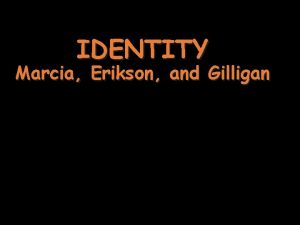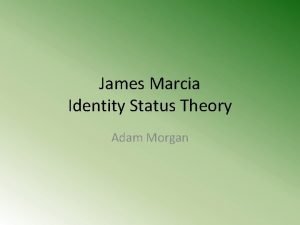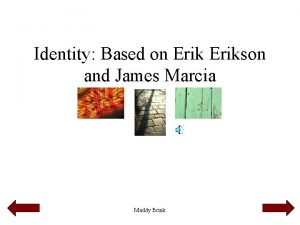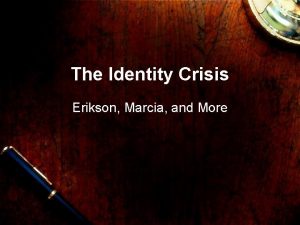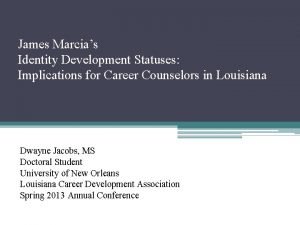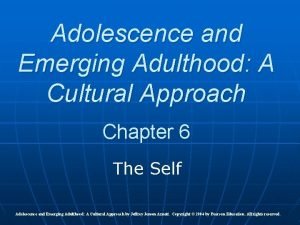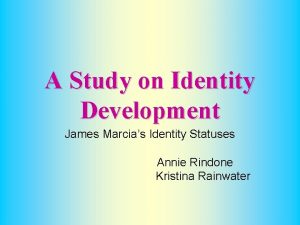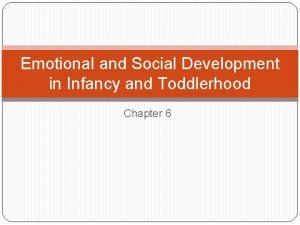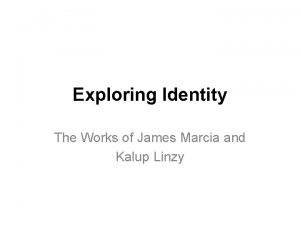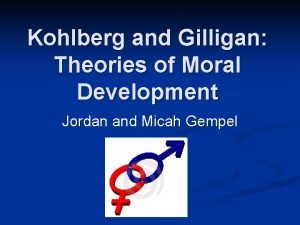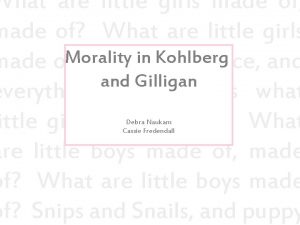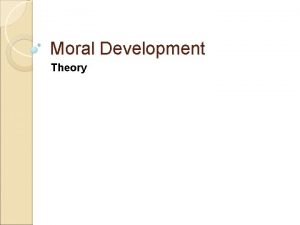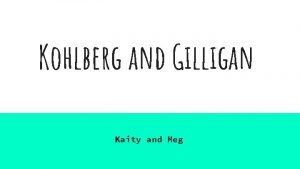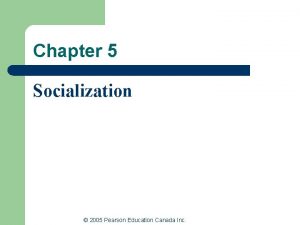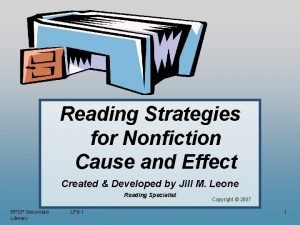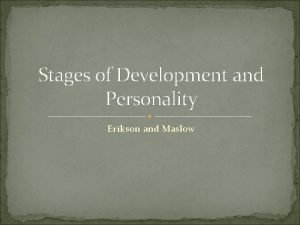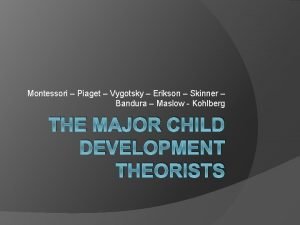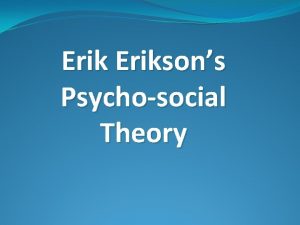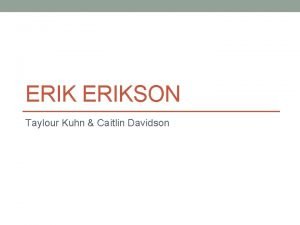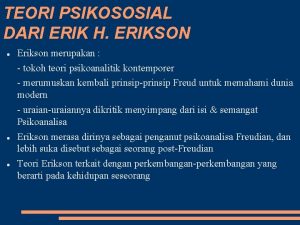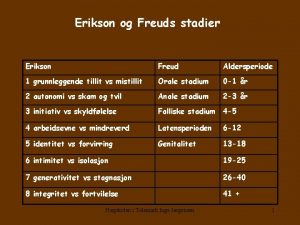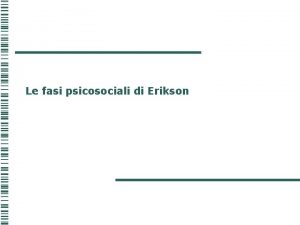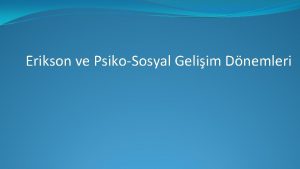IDENTITY Marcia Erikson and Gilligan According to James






































- Slides: 38

IDENTITY Marcia, Erikson, and Gilligan

According to James Marcia, the criteria for attainment of a mature identity are based on two essential variables that Erikson had already identified: crisis/exploration and commitment

Crisis/Exploration • refers to the time during adolescence when the individual actively examines developmental opportunities, identity issues, and questions parentally defined goals and values, and begins to search for personally appropriate alternatives with respect to occupation, goals, values, and beliefs

Commitment • pertains to the extent that the individual is personally involved in, and expresses allegiance to, self-chosen aspirations, goals, values, beliefs, and occupation

Diagram of the Identity Statuses Low Crisis/ Exploration High Crisis/ Exploration Low Commitment High Commitment Identity Diffused Identity Foreclosed Moratorium Identity Achieved

Identity Diffused • has not yet experienced an identity crisis/exploration or made a personal commitment to a vocation or set of beliefs.

Foreclosure • has not yet experienced an identity crisis/exploration but has made definite commitments to goals, values, and beliefs.

Moratorium • is in an acute state of crisis/exploration when the individual is actively seeking and/or examining values to eventually call his/her own.

Identity-Achieved • has gone through the process of exploration/crisis but has resolved the identity issues on own terms.

The specific content areas or decision-making issues that the adolescent is exploring or has made a commitment to are referred to as domains. The domains studied by Marcia and Erikson are • occupation/career • religious beliefs • political values • sex roles and sexuality

• Rather than a static identity, each identity status is an ongoing process. • Identity statuses may be perceived as a developmental sequence, but no one status is necessarily and inevitably a stepping stone for another. • Only moratorium appears to be an essential and inevitable prerequisite for the achievement of an identity. • Individuals in the process of moving to higher statuses may exhibit some of the characteristics of two or perhaps even three statuses at the same time.

A Closer Look at the Identity Statuses

Identity Diffusion • The identity-diffused individual has not explored identity issues actively or gone through a genuine struggle in terms of reevaluating, searching, considering, and deciding personal alternatives • This status can encompass a variety of different behavior patterns, from an aimless drifting, to a manipulative selfishness, to a morbid self-preoccupation

Identity Diffusion • A classic example of identity diffusion in literature is Shakespeare’s Prince Hamlet.

Foreclosure • The most frequently observed identity status during adolescence • While it declines with increasing age, it remains prevalent even in adulthood. • The foreclosed individual is committed to goals and values, an occupation, and a personal ideology • Superficially appear very much like identityachieved individual.

Foreclosure • Foreclosed individuals differ from identityachieved individuals in that they have not gone through the reflective process of intensive searching and personal exploration • The goals they aim for and the values and beliefs they endorse are typically those adapted from parents or other “models, ” such as relatives, media personalities, ministers, or peers.

Foreclosure • Foreclosed individuals are “socialized by” or “identified with” their parents to the extent that parental values rather than personally explored convictions define their commitment. • College serves mainly to reconfirm the childhood value system and to provide an opportunity to attain the individual foreclosed goals rather than as a conscious process to explore vocational options.

Danger: Structured Foreclosure • Foreclosed individuals can become so solidified in their position and in their attitudes that their identity status becomes terminal. • Consequently, they may not move easily toward reaching the status of identity achievement. • “Midlife crisis” is often a result of terminal foreclosure.

Foreclosure: Peer Group Conformity • Foreclosure occurs because the individual’s identity submerges too readily and without exploring other alternatives into the roles prescribed for them by others.

Foreclosure: Peer Group Conformity n adolescents define themselves primarily by their group membership.

Foreclosure: Peer Group Conformity n Foreclosed individuals act, dress, select food and entertainment, and use language and slang expressions in conformity to peer group standards, expectations, and pressures.

Moratorium • Definition: a period of delay granted to somebody who is not yet ready to meet an obligations or make a commitment. • Individual is in an active struggle to find answers, to search, to explore, to try on different roles, and to “play the field. ” • Individual can still change values and modify commitments … in the process of gaining new experiences and exploring a variety of new roles.

Moratorium • According to Marcia, moratorium is an essential and necessary prerequisite for identity achievement. • Individuals in moratorium are inclined to express their disenchantment by challenging what they see and hear. • Their desire is to change institutions such as the government, politics, the church, and education.

Identity Achievement • After one has experienced a psychological moratorium and has explored identity issues and crises, and, as a result, has begun to develop more permanent personal commitments, one has then achieved an identity. • Identity achievement means that the adolescent has found a new synthesis that “will link the past, present, and the future. ”

One more thing… • Individuals who have achieved an identity will not necessarily - or even likely - remain in that status without changing. • They may re-enter a period of exploration or crisis if the chosen identity element does not work out for some reason or if more appealing alternatives come up that could precipitate a crisis over whether or not to change.

This can result in a… MAMA CYCLE Moratorium Achievement Motivation Achievement

Gender Differences in the Achievement of an Identity

Findings… • In most traditional domains (e. g. , vocational choice, religious beliefs, political ideology), males and females follow a similar pattern of identity status distribution. • The timing of identity formation for both sexes appears to be about the same. • Personality correlates of each of the identity statuses (e. g. , authoritarianism, anxiety, concept formation) tend to be the same for both sexes.

However…females confront a more complex task in forming their identity than do males: • Girls and women are concerned with their own sense of self and are more concerned than are boys or men with the impact of their self on significant people in their lives. • Girls and women are more likely to have experienced an exploration/crisis period in terms of defining their sexual identity. • Girls and women tend to experience greater complexity in terms of making decisions pertaining to family and career choices than do boys or men.

Erikson suggested … • that identity precedes intimacy for males, but that, for females, either identity follows intimacy or both emerge simultaneously. • that identity remains incomplete for a female until she bonds with a man.

Gilligan proposes … • that males and females adopt two fundamentally different voices • Males develop an “ethic of justice” • Females develop an “ethic of care” • that while for males identity emerges before intimacy, for at least some females identity and intimacy are apparently fused

Summary Except for the resolution of a personal value system regarding sexuality, male and female identity development patterns seem virtually identical.

Summary Obviously, the continued double standard requires females to make careful sexual decisions since they bear the social and often economic consequences of contraception and abortion (or single unwed parenthood).

Erikson’s description of Women’s Inner Space

Women’s Inner Space • The core concept in defining woman’s sexuality/identity • As a woman forms her sexual identity during puberty and the following decade, she must develop her sexual values and standards and decide whether, when, under what circumstances, and whom to permit entry into her “Inner Space. ”

Findings… • boys and girls tend to structure their space quite differently • “girls emphasized inner space, boys emphasize outer space”

Erikson adds that … • interpersonal concerns create the core of female identity, with vocational and ideological issues remaining less important. • issues of identity, intimacy, and generativity could be dealt with simultaneously rather than sequentially

Educational Implications • schools seem to be encouraging foreclosure to the extent that they demand conformity to the status quo and submission to authority rather than aiding the adolescent in the search for and exploration of a personal identity.
 According to james marcia, identity status is based on
According to james marcia, identity status is based on James marcia identity theory
James marcia identity theory Identity diffusion
Identity diffusion Erikson and marcia
Erikson and marcia James marcia identitätsentwicklung
James marcia identitätsentwicklung Identity foreclosure
Identity foreclosure Eli the fanatic
Eli the fanatic Marcia's four identity statuses
Marcia's four identity statuses Marcia's four identity statuses
Marcia's four identity statuses According to erikson's theory, a mistrustful baby
According to erikson's theory, a mistrustful baby James marcia
James marcia Marcia's stages
Marcia's stages Carol gilligan theory of moral development stages
Carol gilligan theory of moral development stages Carol gilligan criticized kohlberg's theory for
Carol gilligan criticized kohlberg's theory for Itaat ve ceza eğilimi örnek
Itaat ve ceza eğilimi örnek Kohlberg morality test
Kohlberg morality test Carol gilligan criticized kohlberg's theory for
Carol gilligan criticized kohlberg's theory for Kohlberg’s theory of moral development
Kohlberg’s theory of moral development Carol gilligan moral development theory
Carol gilligan moral development theory Carol gilligan ahlak gelişimi
Carol gilligan ahlak gelişimi Care ethik carol gilligan
Care ethik carol gilligan Gilligan kohlberg
Gilligan kohlberg Meg
Meg Carol gilligan
Carol gilligan Carol gilligan
Carol gilligan Russell odom and clay lawson
Russell odom and clay lawson Russell odom and clay lawson
Russell odom and clay lawson Personal identity map
Personal identity map Cause and effect non fiction
Cause and effect non fiction John and marcia monthly spending plan 1 answer key
John and marcia monthly spending plan 1 answer key Erikson and maslow
Erikson and maslow Vygotsky vs bandura
Vygotsky vs bandura Sigmund freud and erik erikson
Sigmund freud and erik erikson Marcia pereira
Marcia pereira Marcia rose ewan bremner
Marcia rose ewan bremner Pietro cortelli
Pietro cortelli Marcia tecnica
Marcia tecnica Canzone la marcia dei diritti
Canzone la marcia dei diritti Melissa has 3 fewer apples than marcia
Melissa has 3 fewer apples than marcia
